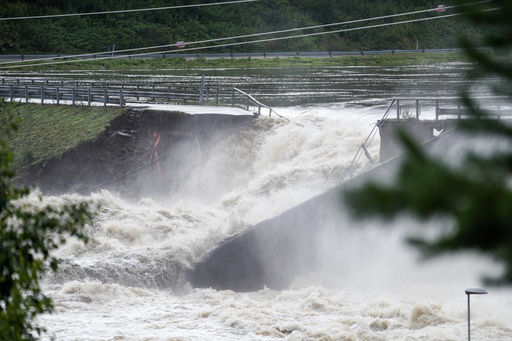
Water breaks through the dam at Braskereidfoss, Norway, Wednesday, Aug. 9, 2023. AP
COPENHAGEN, Denmark — A dam in southern Norway partially burst Wednesday following days of heavy rain that triggered landslides and flooding in the mountainous region and forced downstream communities to evacuate, officials said.
Authorities initially considered blowing up part of the dam at the Braskereidfoss hydroelectric power plant on the Glåma, Norway’s longest and most voluminous river. The idea was to prevent communities downstream from being inundated by using a limited, controlled blast to release pressure on the dam.
But that proposal was scrapped after water later broke through the structure, police spokesman Fredrik Thomson told reporters.
“The damage from a possible explosion of the concrete plant would be so great that it would serve no purpose,” Thompson said.
Now officials are hopeful that they will see a gradual, even leveling of the water, Thompson said.
Norwegian Prime Minister Jonas Gahr Støre warned that flooding would continue to be a threat as excess water flows downstream.
“This is by no means over,” he said. “It could be the highest water level in 50 years or more.”
The dam’s generators stopped working early Wednesday after a power grid failure, plant operator Hafslund Eco said in a statement.
An automatic system that should have opened the floodgates to release water failed. Rapidly rising water then spilled over the dam and into the power station itself, which caused major damage, officials said.
Huge volumes of water were pouring over the western parts of the dam, Thomson said.
The water ripped apart a two-lane road and fences that ran across the top of the dam.
Per Storm-Mathisen, a spokesman for the power station operator, told the Norwegian news agency NTB that the water diversion seemed to be “going well.”
\
Parts of a camping area are completely flooded with water after the Dokka River has overflowed its banks in Dokka, Norway, Wednesday, Aug. 9, 2023. AP
At least 1,000 people live in communities close to the river in the area, and authorities said that all were evacuated before the dam began to fail.
In other developments Wednesday, a Norwegian woman in her 70s died after falling into a stream the day before. She managed to crawl up onto the bank, but because of the floods, it took rescue teams several hours to bring her to a hospital, police said.
More than 600 people were evacuated in a region north of Oslo, and police in southern Norway reported that the situation there was “unclear and chaotic.” All main roads between Oslo and Trondheim, Norway’s third-largest city, were closed, according to the Norwegian Public Roads Administration.
”We are in a crisis situation of national dimensions,” Innlandet County Mayor Aud Hove said. “People are isolated in several local communities, and the emergency services risk not being able to reach people who need help.”
The weather system known as Storm Hans has battered parts of Scandinavia and the Baltics for several days, causing rivers to overflow, damaging roads and knocking down branches that injured people.
Scientists have not done the intricate data analysis needed to see how much, if any, human-caused climate change played a role in the flooding. But they have long warned that, as the world warms, extreme storms will produce larger amounts of rain in bigger bursts.
One major reason is that the warmer the air is, the more water it can hold. Also, many scientists say changes in the jet stream — the atmospheric currents that propel weather systems — often lead to storms stalling over places and dumping more rain. Those changes could be connected to climate change.
Two hydrologists said the conflict between old dams and heavier amounts of rain is becoming a more frequent problem.
University of Virginia hydrologist Venkat Lakshmi said his research shows that older dams are unprepared to handle rainfall that comes in heavier, harder-to-manage bursts.
Many of those dams were designed to withstand floods that were supposed to happen only once a century, but those events are now happening much more often, he said.
“This type of conflict between climate and our hydrological infrastructure, such as dams, is going to become more common,” said UCLA hydrologist Park Williams. As rainfall intensifies, reservoirs and dams “will be increasingly out of tune with the changing climate.”
Meanwhile, the flooding in southern Norway and central Sweden carried away sheds, small houses and mobile homes.
Norwegian meteorologists predicted that up to 30 millimeters (1.2 inches) of additional rain could fall by Wednesday evening, saying “the quantities are not extreme, but given the conditions in the area, the consequences may be.”
In neighboring Sweden’s second-largest city, Goteborg, large parts of the harbor were under water.
Weather agencies for both countries issued urgent warnings.
Erik Hojgard-Olsen, a meteorologist with the Swedish Meteorological and Hydrological Institute, told the Aftonbladet newspaper that the weather was unusual for this time of year.
“It is exceptional to have such a low pressure (system) as Hans, which has brought so much rain for several days in a row,” he said. “Especially for being a summer month, it has lasted a long time.”
The Norwegian Water Resources and Energy Directorate said record high flood levels were recorded in several places in the Drammensvassdraget, a drainage basin west of Oslo, the capital.
Erik Holmqvist, a senior engineer at the agency, said four lakes. including the Randsfjorden, the fourth-largest in Norway, were particularly vulnerable to flooding.
“We have to go all the way back to 1910 to get the same forecasts for the Randsfjorden,” Holmqvist told the VG newspaper.